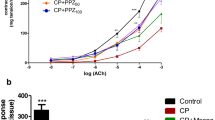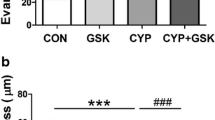Abstract
We investigated the attenuated effect of intravesical epinephrine (EPI) on uroplakin II (UPII) expression in cyclophosphamide (CYP)-induced rat cystitis. Sixty-eight Sprague-Dawley female rats were divided into one negative control group (GI) and five intraperitoneally CYP (150 mg CYP/kg)-injected groups (GII-VI) consisting of a positive control group (GII), three groups (GIII-V) with retaining intravesically instillated ameliorating agents for 90 min by urethral ligation until sacrifice, and one group (GVI) with freely voiding after intravesical EPI instillation. The retention groups were further classified into null-treated- (GIII), EPI- (GIV), and vehicle group (GV). All rats were euthanized 24 h after CYP injection. The UPII and α1-adrenergic receptors (AR) levels were measured with real-time polymerase chain reaction (RT-PCR) method and the morphological changes were also evaluated. CYP induced severe cystitis and decreased vesical UPII mRNA level. The EPI-treated groups had showed attenuation effects against submucosal edema and hemorrhage, and preserved UPII expression. Concurrently, intravesical EPI resulted in a significant preservation of both subtypes of α1A- and α1B AR expressions, which was well correlated with the hemostatic pattern in the samples. The obstructed and null-treated group (GIII) revealed severe cystitis and maximally decreased UPII levels, and the diluting effect of vehicle (GV) on CYP toxicity was insignificant on UPII preservation. The UPII level of RT-PCR was well correlated with the UPII immunohistological expression and their morphological changes. Intravesical instillation of EPI preserves UPII expression and attenuates the toxic responses in the bladder in CYP-induced rat cystitis.






Similar content being viewed by others
References
Al-Rawithi S, El-Yazigi A, Ernst P et al (1998) Urinary excretion and pharmacokinetics of acrolein and its parent drug cyclophosphamide in bone marrow transplant patients. Bone Marrow Transplant 22:485–490
Choi SH, Byun Y, Lee G (2009) Expressions of uroplakins in the mouse urinary bladder with cyclophosphamide-induced cystitis. J Korean Med Sci 24:684–689
Chow YC, Yang S, Huang CJ et al (2006) Epinephrine promotes hemostasis in rats with cyclophosphamide-induced hemorrhagic cystitis. Urology 67:636–641
Chow YC, Yang S, Huang CJ et al (2007) Prophylactic intravesical instillation of epinephrine prevents cyclophosphamide-induced hemorrhagic cystitis in rats. Exp Biol Med (Maywood) 232:565–570
Cox PJ (1979) Cyclophosphamide cystitis—identification of acrolein as the causative agent. Biochem Pharmacol 28:2045–2049
Elias A, Ryan L, Sulkes A et al (1989) Response to mesna, doxorubicin, ifosfamide, and dacarbazine in 108 patients with metastatic or unresectable sarcoma and no prior chemotherapy. J Clin Oncol 7:1208–1216
Fukushima S, Arai M, Cohen SM et al (1981) Scanning electron microscopy of cyclophosphamide-induced hyperplasia of the rat urinary bladder. Lab Invest 44:89–96
Giné E, Rovira M, Real I et al (2003) Successful treatment of severe hemorrhagic cystitis after hemopoietic cell transplantation by selective embolization of the vesical arteries. Bone Marrow Transplant 31:923–925
Hornberger J, Reyes C, Lubeck D et al (2008) Economic evaluation of rituximab plus cyclophosphamide, vincristine and prednisolone for advanced follicular lymphoma. Leuk Lymphoma 49:227–236
Hu P, Deng FM, Liang FX et al (2000) Ablation of uroplakin III gene results in small urothelial plaques, urothelial leakage, and vesicoureteral reflux. J Cell Biol 151:961–972
Katz A, Epelman S, Anelli A et al (1995) A prospective randomized evaluation of three schedules of mesna administration in patients receiving an ifosfamide-containing chemotherapy regimen: sustained efficiency and simplified administration. J Cancer Res Clin Oncol 121:128–131
Koss LG (1967) A light and electron microscopic study of the effects of a single dose of cyclophosphamide on various organs in the rat. I. The urinary bladder. Lab Invest 16:44–65
Kyung YS, Park HY, Lee G (2011) Preservation of uroplakins by 2-mercaptoethanesulfonate in cyclophosphamide-induced rat cystitis. Arch Toxicol 85:51–57
Letendre L, Hoagland HC, Gertz MA (1992) Hemorrhagic cystitis complicating bone marrow transplantation. Mayo Clin Proc 67:128–130
Levin RM, Wein AJ (1979) Distribution and function of adrenergic receptors in the urinary bladder. Mol Pharmacol 16:441–448
Moon MJ, Park JG (2009) Fine structural analysis of the attachment devices in the jumping spider Plexippus setipes. Korean J Microsc 39:149–156
Santos GW, Tutschka PJ, Brookmeyer R et al (1983) Marrow transplantation for acute nonlymphocytic leukemia after treatment with busulfan and cyclophosphamide. N Engl J Med 309:1347–1353
Schwinn DA (2001) The role of alpha1-adrenergic receptor subtypes in lower urinary tract symptoms. BJU Int 88:27–34
Takamoto S, Sakura N, Namera A et al (2004) Monitoring of urinary acrolein concentration in patients receiving cyclophosphamide and ifosphamide. J Chromatogr B Analyt Technol Biomed Life Sci 806:59–63
Wantuch C, Piesla M, Leventhal L (2007) Pharmacological validation of a model of cystitis pain in the mouse. Neurosci Lett 421:250–252
Wu XR, Manabe M, Yu J, Sun TT (1990) Large scale purification and immunolocalization of bovine uroplakins I, II, and III. Molecular markers of urothelial differentiation. J Biol Chem 265:19170–19179
Wu XR, Medina JJ, Sun TT (1995) Selective interactions of UPIa and UPIb, two members of the transmembrane 4 superfamily, with distinct single transmembrane-domained proteins in differentiated urothelial cells. J Biol Chem 270:29752–29759
Acknowledgments
This work was supported by the grant from Institute of Bio-Science and Technology at Dankook University in 2010.
Author information
Authors and Affiliations
Corresponding author
Rights and permissions
About this article
Cite this article
Kyung, Y.S., Park, H. & Lee, G. Intravesical epinephrine preserves uroplakin II expression in urinary bladder from cyclophosphamide-induced rat cystitis. Naunyn-Schmiedeberg's Arch Pharmacol 385, 769–776 (2012). https://doi.org/10.1007/s00210-012-0761-z
Received:
Accepted:
Published:
Issue Date:
DOI: https://doi.org/10.1007/s00210-012-0761-z




